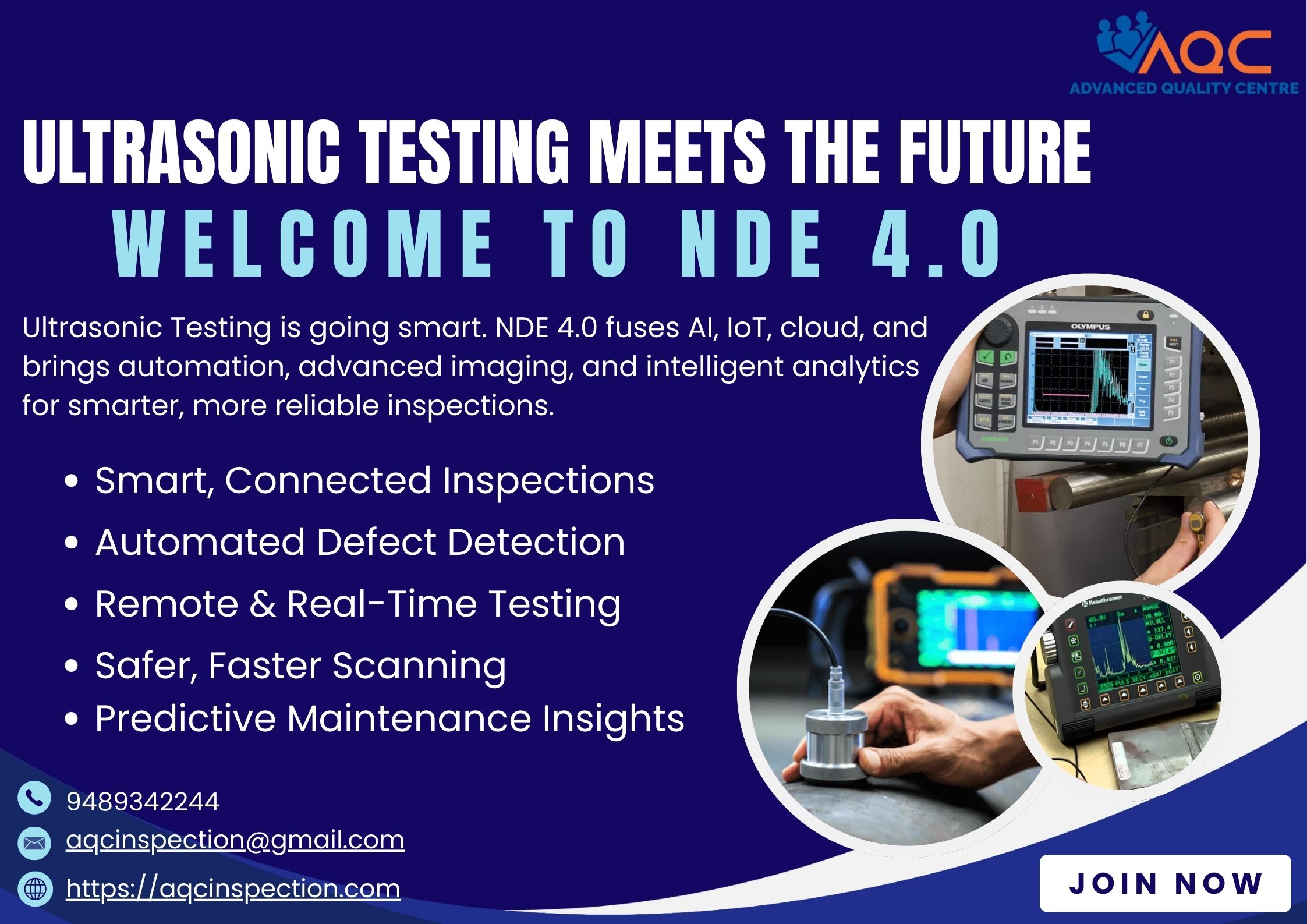Introduction
Since the earliest applications of industrial quality control, the Non-Destructive Evaluation (NDE) has been highlighted because its testing method is able to determine if a structure has its integrity preserved after manufacturing processes such as machining and welding without causing any damage on to the materials to be inspected. The modern-day NDE is referred to as NDE 4.0, where automation, digital transformation, artificial intelligence (AI), and the Internet of Things (IoT) are now integrated into inspection processes in alignment with Industry 4.0. Introduction to NDE 4.0 is leading Ultrasonic Testing (UT), a well-known NDE technique, through a transitional phase, bringing it in parallel with the need for higher accuracy, faster inspections, and data-driven decision-making.
Understanding NDE 4.0 and Its Impact on Ultrasonic Testing
What is NDE 4.0?
The highest level of evolution in the world of Non-Destructive Testing (NDT) is NDE 4.0, which corresponds to the “fourth industrial revolution,” or Industry 4.0 for short, that has begun taking over targeted portions of manufacturing and industrial processes all around the world.
- Digitalization of inspection processes
- Automation through robotics and AI
- Cloud computing and IoT data integration
- Predictive analytics for proactive maintenance
Why is Ultrasonic Testing a Key Focus in NDE 4.0?
- UT is commonly employed in all sectors of aerospace, oil & gas, automotive, and power generation plants.
- Standard UT methods are slow and operator reliant.
- All automatic recognition, real-time monitoring, and AI-based analysis applied to UT by NDE 4.0
Key Technological Advancements in Ultrasonic Testing with NDE 4.0
Ultrasonic Testing (UT) is one of the oldest and most established nondestructive evaluation techniques, which employs high-frequency sound waves to examine materials. Until the appearance of NDE 4.0, however, UT is being revolutionized from a manual/operator-dependent procedure into an intelligent, automated, and data-driven inspection system.
-
Digital Transformation in Ultrasonic Testing
- Phased Array Ultrasonic Testing (PAUT) and Total Focusing Method (TFM) replace conventional convoluted transducers with high-resolution digital sensors.
- Complex Geometries: FMC for advanced imaging.
- Wireless UT devices queue up inspection data to cloud platforms in real time.
-
Artificial Intelligence and Machine Learning at UT
- This makes the defect detection even more effective, as errors due to humans are eliminated in identifying flaws!!
- Deep learning models used to compare historical data for material failure prediction
- Machine learning assisted defect classification improves the consistency of reporting.
-
IoT and Cloud-Based Ultrasonic Testing
- The key feature of a remote monitoring system is that experts can inspect the place from anywhere.
- Inspection records are kept in centralized cloud databases so they can be easily accessed.
- Using UT trends to predict failures is part of predictive maintenance, which otherwise simply repairs when you have failed.
-
Augmented Reality (AR) and Virtual Reality (VR) in UT Inspections
- AR overlays show defect maps of inspected components, live.
- VR training for NDT technicians lets them do complicated UT procedures in the virtual world risk-free.
-
Robotics and Automation in Ultrasonic Testing
- UT can be done in dangerous environments (e.g., pipelines, nuclear reactors) using crawler robots and drones.
- Inspection speed and, more importantly, repeatability are enhanced by automated scanning systems.
- Collaborative robots work with human inspectors on the factory floor of major industries.
Benefits of NDE 4.0 in Ultrasonic Testing
NDE 4.0 principles are being inculcated into other NDT methods, be they traditional or modern, for industrial inspections where advanced solutions outmanoeuvre the conventional ones, as we have seen with Ultrasonic Testing (UT).
-
Improved Accuracy and Reliability
- Less bogus reads and wrong rejects with AI in defect detection.
- The higher-resolution transparent fuel model (TFM) images with FMC offer more complete scans.
-
Faster and More Efficient Inspections
- In manufacturing plants, automation scanning reduces downtime.
- Instant decision-making with real-time data analysis.
-
Enhanced Safety for Inspectors
- The best example is robots and drones, which survey hazardous zones such as radiation areas or deep-sea pipelines.
- Lack of human intervention reduces work site accidents.
-
Data-Driven Asset Management
- Cloud-based analytics improve long-term structural health monitoring. Another element of structural health monitoring, long-term cloud-based analytics
- This also results in everything being on a digital record, providing traceability to industry standards.
Challenges and Limitations of NDE 4.0 in Ultrasonic Testing
Advancements to Ultrasonic Testing (UT) in NDE 4.0 While the breakthroughs offered by NDE 4.0 bring significant improvements to ultrasonic testing, several major obstacles remain. Industries must overcome these challenges to fully implement these technologies.
-
High Initial Investment Costs
- Advanced UT ecommerce (PAUT, AI) requires a large investment.
- Small and medium-sized enterprises (SMEs) might struggle with adoption.
-
Need for Skilled Workforce
- Data analytics, robotics, and artificial intelligence are focused on training.
- Conventional NDE specialists tend to face a learning curve.
-
Data Security and Cybersecurity Risks
- Cloud-based UT systems can be vulnerable to data breaches and hacking.
- It plays vital role in ensuring secure data transfer.
Future Trends in NDE 4.0 and Ultrasonic Testing
Ultrasonic Testing (UT) is set for major advancements as Industry 4.0 reshapes infrastructure and manufacturing. NDE 4.0 combines AI, advanced robotics, and quantum sensing, creating new opportunities in autonomous inspections, predictive analytics, and defect detection.
-
Self-Learning AI for Ultrasonic Testing
- Neural networks will continually improve defect detection accuracy.
- Inspections will be customized by adaptive algorithms based on material behaviour.
-
Quantum Sensors for Ultra-High-Resolution Imaging
- Quantum-enhanced UT sensors can detect nanoscale flaws.
- These sensors may be used in advanced composites and semiconductors.
-
Blockchain for Secure UT Data Management
- Blockchain ensures tamper-proof inspection records.
- This technology improves traceability in the defence and aerospace industries.
-
Digital Twins for Predictive Maintenance
- Virtual versions of industrial assets simulate real-time UT inspections.
- AI predicts system failures before they occur.
FAQ: Common Questions About NDE 4.0 and Ultrasonic Testing
Q1: In what ways does NDE 4.0 improve on conventional ultrasonic testing?
A: NDE 4.0 provides inspections that are more reliable and digitally traceable faster than conventional UT inspections that create greater subjectivity due to more manual interpretation. NDE 4.0 employs AI, IoT, automation, etc.
Q2: Eventually will NDE 4.0 take over from human inspectors?
A: No, but it will enhance their capabilities. Humans will still be needed to operate the robots during hazardous inspections; also, humans will still need AI assistance to analyze and interpret inspection data.
Conclusion
In conclusion, NDE 4.0 is the evolution of ultrasonic testing, making it smarter, more reliable, and faster than conventional processes. It can provide those specific industries a level of accuracy, safety, and cost savings that are impossible to replicate. Ultrasonic testing will provide quality assurance and predictive maintenance into Industry 4.0 through advanced technology such as AI, robotics, cloud computing, and IoT technology. As Industry 4.0 expands, ultrasonic testing and compliance will provide a vital component of structural integrity. The machines and humans in the automated world will be bound to work in concert to create an integrated digital representation to deliver and maintain structural integrity. This is the future of ultrasonic testing.
Educational Resources & References
- ASNT (American Society for Non-destructive Testing): www.asnt.org
- Open Access NDT Database (NDT.net): www.ndt.net
- Research Papers on NDE 4.0 (IEEE Xplore): www.ieee.org
- European Federation for NDT (EFNDT): www.efndt.org
- NDE Reports from the International Atomic Energy Agency (IAEA): www.iaea.org



